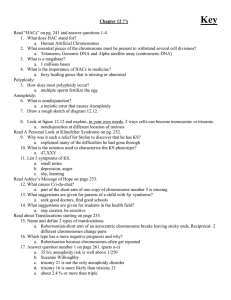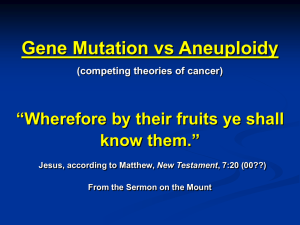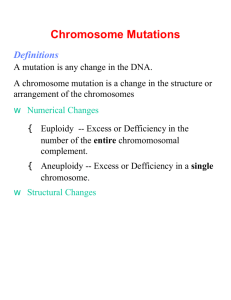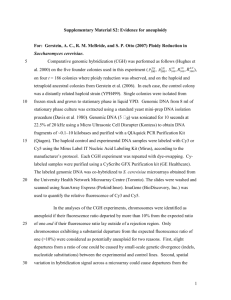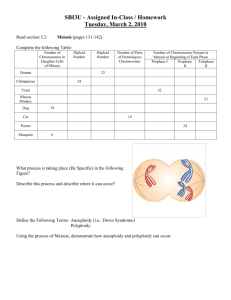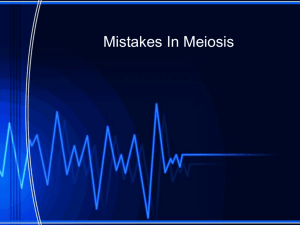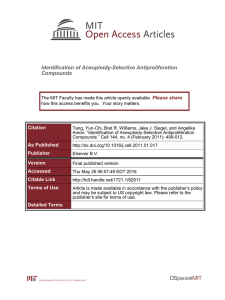Aneuploidy: Cancer's Fatal Flaw? Please share
advertisement
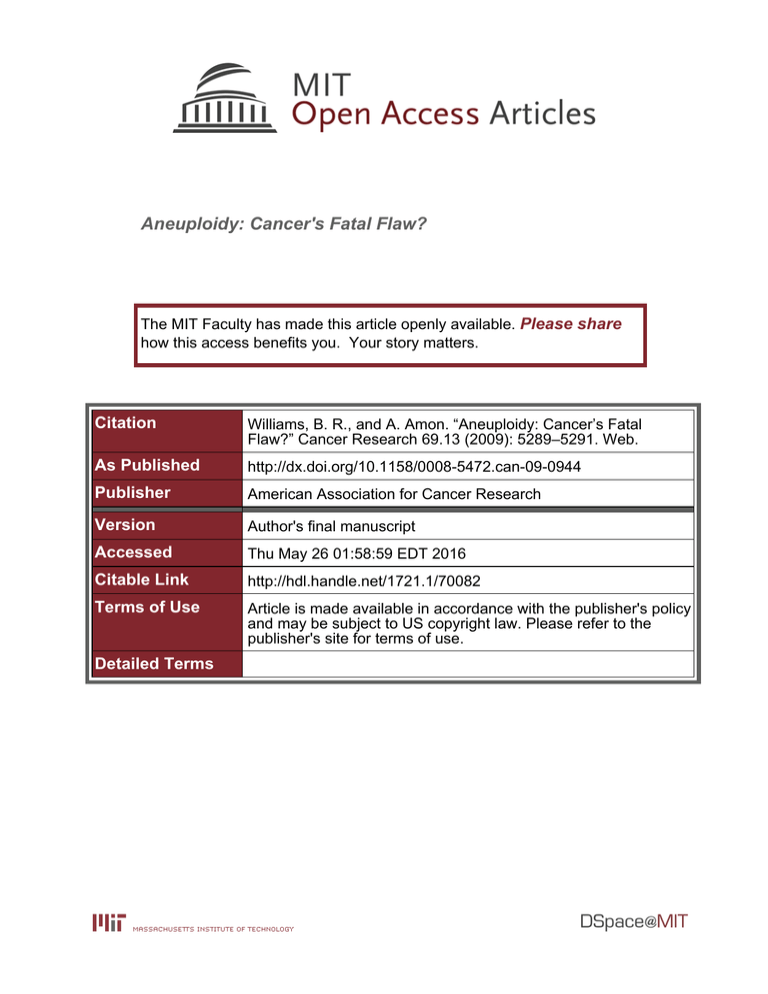
Aneuploidy: Cancer's Fatal Flaw? The MIT Faculty has made this article openly available. Please share how this access benefits you. Your story matters. Citation Williams, B. R., and A. Amon. “Aneuploidy: Cancer’s Fatal Flaw?” Cancer Research 69.13 (2009): 5289–5291. Web. As Published http://dx.doi.org/10.1158/0008-5472.can-09-0944 Publisher American Association for Cancer Research Version Author's final manuscript Accessed Thu May 26 01:58:59 EDT 2016 Citable Link http://hdl.handle.net/1721.1/70082 Terms of Use Article is made available in accordance with the publisher's policy and may be subject to US copyright law. Please refer to the publisher's site for terms of use. Detailed Terms Aneuploidy –Cancer’s Fatal Flaw? Bret R. Williams and Angelika Amon* David H. Koch Institute for Integrative Cancer Research Howard Hughes Medical Institute Massachusetts Institute of Technology, E17-233 40 Ames Street Cambridge, MA 02139 USA * To whom correspondence should be addressed. e-mail: angelika@mit.edu 1 Abstract Aneuploidy is a characteristic of cancer, with greater than 90 percent of all solid tumors in humans carrying an aberrant karyotype. Yet whether and how this condition contributes to tumorigenesis is not understood. Here we summarize our recent findings on the effects of aneuploidy on cell physiology and proliferation. These studies suggest that aneuploidy puts significant stress on the cell, which responds to this condition in what can be viewed as an aneuploidy stress response. We will discuss how our results may bear on our understanding of the role of this condition in tumorigenesis and how they may provide new opportunities for treatment of the disease. Background Aneuploidy is defined as the alteration of chromosome number that is not a multiple of the haploid complement. This condition is different than that of polyploidy, in which cells harbor a multiple of their haploid karyotype. While polyploidy is reasonably well tolerated on both the cellular and organismal level, aneuploidy is not, with the condition frequently being associated with death and severe developmental abnormalities in all organisms analyzed to date (1). In humans, disease conditions have been described where aneuploidy affects the entire individual or a subset of cells. In cases where aneuploidy is observed system-wide, the degree of aneuploidy is limited to only one additional chromosome and the consequences for the individual are severe. Embryos with autosomal monosomies have never been identified among spontaneous abortions and multiple trisomies are extremely rare indicating that these conditions lead to gamete and/or early embryonic lethality (2). Only three autosomal trisomies exist that survive to birth. These are trisomy 13, 18, and 21, Patau, Edward, and Down syndrome respectively, with only Down syndrome patients surviving to adulthood. The most prominent disease where aneuploidy is observed at the cellular level is cancer, a disease of hyper-proliferation. Here 2 aneuploidy is not restricted to one chromosome but the disease is characterized by a high degree of numeric as well as structural karyotypic abnormalities (3). Taken together, these observations raise an interesting conundrum. How is it possible that the presence of a single extra chromosome leads to death of an individual early in embryonic development (3), but at the cellular level severe karyotypic abnormalities are associated with unabated proliferative potential? To begin to shed light on this question, we characterized the effects of aneuploidy on mammalian cell proliferation and physiology. These studies showed that the presence of even a single extra chromosome is detrimental to normal euploid mouse embryonic fibroblasts (MEFs), confirming the adverse effects described at the organsimal level (4). More importantly, the systematic study of several MEF lines each harboring a different trisomy revealed that these cell lines share a set of phenotypes that is independent of the identity of the additional chromosome and that is similar to the shared phenotypes observed in a series of aneuploid yeast strains studied previously (5). These phenotypes and how they may be exploited in the fight against cancer will be discussed below. The consequences of aneuploidy. In 1974, Segal and McCoy reported that primary foreskin fibroblasts of Trisomy 21 patients proliferate more slowly than euploid control cells (6). Similar results were obtained from studies of primary mouse cells (7) or human cell lines (8) with decreased chromosome segregation fidelity. We set out to characterize the effects of a single extra chromosome on cell growth and proliferation in a systematic manner. This approach not only enabled us to determine whether or not every chromosome when present in an extra copy interferes with proliferation, but also allowed us to determine whether a general response to aneuploidy exists. We established mouse embryonic fibroblasts trisomic for either chromosome 1, 13, 16 or 19 using mice with balanced Robertsonian translocations. Analysis of the cell lines established from these aneuploid embryos revealed that cell 3 proliferation was hampered in all trisomic MEFs compared to euploid controls. Furthermore, the characterization of the trisomic MEFs revealed a number of shared traits. The trisomic cells were larger in size, which could be indicative of either cell cycle delay or senescence. The trisomic cells also exhibited metabolic alterations with glutamine uptake and ammonium production being increased. In all but one trisomy, lactate production was also elevated raising the possibility that glucose utilization is altered in cells with abnormal karyotypes (4). It is worth noting that on the organismal level, similarities in phenotypes between trisomies also exist. Most if not all trisomies in mice are associated with neuronal hypocellularity, cardiac defects, cleft palate, and skeletal defects (9). These phenotypes are also observed in human trisomies (10). Whether these phenotypes are a consequence of the shared cellular phenotypes or reflect the fact that most chromosomes contain dosage-sensitive genes required for neuronal, heart, and skeletal development remains to be determined. The changes in cell proliferation and altered metabolic properties of trisomic MEFs are reminiscent of the phenotypes observed in yeast strains carrying additional chromosomes. Previous studies of 20 budding yeast strains engineered to carry one or two additional chromosomes showed that in this organism too, aneuploidy leads to a cell proliferation defect (specifically a delay at the G1 – S phase transition), increased cell volume, and metabolic alterations ((5); Christian Gonzalez, Stefan Christen and Uwe Sauer, personal communication). In addition S. cerevisiae strains carrying additional chromosomes exhibit a gene expression pattern characteristic of a general stress response and increased sensitivity to compounds that interfere with protein synthesis, turnover, and folding. Whether or not trisomic MEFs exhibit similar sensitivities is not yet known. What is the basis of the phenotypes shared by aneuploid cells? In S. cerevisiae, it was shown that introduction of artificial mammalian chromosomes similar in size to yeast chromosomes did not lead to the phenotypes observed in strains 4 with additional yeast chromosomes (5). This finding together with the observations that the additional chromosomes are transcribed and translated and that the severity of the shared phenotypes increases with the amount of additional yeast DNA present in cells ((5); E. Torres personal communication) indicates that it is the proteins produced from the additional chromosomes that lead to the phenotypes shared by aneuploid cells. The same is likely to be true in trisomic MEFs. The additional chromosomes are transcribed and the degree of fitness loss in trisomic MEFs correlates with the size of the additional chromosome and the number of transcripts that it generates (4). So how do the proteins produced from the additional chromosomes cause the phenotypes shared by various aneuploid cells? Based on our work in yeast, we proposed that imbalances in cellular protein composition lead to a response that is not unlike a stress response, where pathways are activated that shield cells from the adverse effects of protein imbalances. These include the increase in the turnover of proteins that function in complexes (i.e. ribosomal subunits and histones) and protecting cells from the detrimental effects of partially assembled protein complexes or free subunits by molecular chaperones. The energy required to synthesize the additional proteins and to degrade unwanted proteins is likely to create additional stresses. Indeed, aneuploid yeast cells exhibit a gene expression pattern that is consistent with a general stress response, called the environmental stress response (5, 11). Given that trisomic mouse MEFs share some of the phenotypes of aneuploid yeast cells it is likely that in these cells too, an abnormal karyotype leads to an aneuploidy stress response. Implications for tumorigenesis: Aneuploidy stress in tumor cells. Cancer cells exhibit some of the same phenotypes as primary aneuploid cells raising the interesting possibility that cancer cells may not have been able to completely escape the adverse effects of aneuploidy. Metabolic properties appear to be altered in both cell types. Primary aneuploid cells produce more lactate as do cancer cells. Metabolic profiling showed that yeast aneuploid cells exhibit alterations in carbohydrate metabolism as well (S. Christen and U. Sauer, 5 personal communication). The sensitivities of aneuploid yeast cells to conditions that interfere with protein translation and turnover are also seen in cancer cells. Inhibitors of the molecular chaperone HSP90 have been shown to reduce proliferation of cancer cells (12). The heat shock response is also essential for tumorigenesis. Hsf1, one of the transcription factors that mediate the response to increased temperature, is critical for the development of tumors. Loss of Hsf1, protects p53 deficient mice from tumors and is required for the growth of human cancer cell lines. (13). Similar to reducing tumor burden by inhibiting the heat shock response, the proteasome has also been shown to be a therapeutic target in the treatment of cancer (14). Agents, such as MG132 and Velcade, which inhibit the function of the proteasome activate an apoptotic response or reduce the proliferation of cancer cells. Together, these findings suggest that at least some aspects of the aneuploidy stress response are found in tumors and it is this vulnerability that can be exploited (Figure 1). However, as with many instances in nature, the degree of vulnerability is likely to be determined by many factors including the identity and the degree of the karyotypic aberrations, the tissue in which the aneuploidy occurs, and the genetic state of the cell that acquires the aneuploidy. It is also important to bear in mind, that owing to the severe consequences of aneuploidy on cell proliferation and physiology, the selection for mutations that protect cells from the aneuploidy-induced fitness reduction will be great. Implications for treatment: Exploiting the stressed state of cancer cells. The development of compounds that target pathways that aneuploid cells require for survival, could provide a unique opportunity in the treatment of a broad spectrum of cancers (Figure 1). Inhibitors of protein folding and degradation pathways may lead to preferential death of aneuploid cells. The increase in translational activity may also lead to stresses in aneuploid cells, particularly in cells with a many additional chromosomes. Hampering translation in such cells may lead to selective death of karyotypically abnormal cells. Finally, tumor cells require more energy not only to translate proteins and shield cells from the 6 effects of an unbalanced chromosome complement but also to maintain their high proliferative capacity. Normal cells utilize oxidative phosphorylation for energy production while in many cancers a shift to anaerobic glycolysis is observed. Exploitation of the dependence of cancers on energy production via glycolysis is already being used as a means for therapeutic intervention (15). Several small molecules such as 2-Deoxyglucose and Dichloroacetate inhibit the growth of tumor cells and reduce tumor burden in humans, although the mechanism by which growth inhibition occurs is not completely understood (16). We predict that owing to their increase need for energy, aneuploid cells are in general more vulnerable to compounds that reduce energy production, mimic starvation or down-regulate cellular metabolism than euploid cells. Given the adverse effects of aneuploidy on cell proliferation, cancer cells must have evolved strategies that allowed them to overcome this proliferation barrier. Identifying genetic alterations that permit cells to tolerate aneuploidy using genetic and chemical strategies will provide important insights into tumor evolution. It is also distinctly possible that aneuploid cells harbor additional sensitivities that have not been discovered yet. Screening for compounds or gene knock-downs that inhibit proliferation of aneuploid cells or kill them but do not affect euploid cells may not only shed light on the biological consequences of abnormal karyotypes but could lead to the development of potent inhibitors of tumorigenesis. Figure 1: The stresses associated with aneuploidy – a weakness that can be exploited. A cell with a highly abnormal karyotype experiences stresses due to imbalances in intracellular protein composition. Cells respond to these stresses (shown as orange-shaded boxes) by degrading excess proteins or by engaging chaperones that shield cells from the adverse effects of these protein imbalances. Metabolic activity is also increased in aneuploid cells precipitated by the increased demand 7 for energy to produce the additional proteins and neutralize their effects. The consequences of aneuploidy (shown as blue-shaded boxes), increased sensitivity to conditions that interfere with protein synthesis and turn-over as well as an increase need for energy could be exploited in cancer therapies. Intracellular structures not to scale. 1. Torres EM, Williams BR, Amon A. Aneuploidy: cells losing their balance. Genetics 2008;179:737-­‐46. 2. Hassold TJ, Jacobs PA. Trisomy in man. Annu Rev Genet 1984;18:69-­‐97. 3. Albertson DG, Collins C, McCormick F, Gray JW. Chromosome aberrations in solid tumors. Nat Genet 2003;34:369-­‐76. 4. Williams BR, Prabhu VR, Hunter KE, et al. Aneuploidy affects proliferation and spontaneous immortalization in mammalian cells. Science 2008;322:703-­‐9. 5. Torres EM, Sokolsky T, Tucker CM, et al. Effects of aneuploidy on cellular physiology and cell division in haploid yeast. Science 2007;317:916-­‐24. 6. Segal DJ, McCoy EE. Studies on Down's syndrome in tissue culture. I. Growth rates and protein contents of fibroblast cultures. J Cell Physiol 1974;83:85-­‐90. 7. Baker DJ, Jeganathan KB, Cameron JD, et al. BubR1 insufficiency causes early onset of aging-­‐associated phenotypes and infertility in mice. Nat Genet 2004;36:744-­‐9. 8. Thompson SL, Compton DA. Examining the link between chromosomal instability and aneuploidy in human cells. J Cell Biol 2008;180:665-­‐72. 9. Dyban AP, Baranov VS. Cytogenetics of mammalian embryonic development. Oxford New York: Clarendon Press ; Oxford University Press; 1987. 10. Roizen NJ, Patterson D. Down's syndrome. Lancet 2003;361:1281-­‐9. 11. Gasch AP, Spellman PT, Kao CM, et al. Genomic expression programs in the response of yeast cells to environmental changes. Mol Biol Cell 2000;11:4241-­‐57. 12. Bagatell R, Whitesell L. Altered Hsp90 function in cancer: a unique therapeutic opportunity. Mol Cancer Ther 2004;3:1021-­‐30. 13. Dai C, Whitesell L, Rogers AB, Lindquist S. Heat shock factor 1 is a powerful multifaceted modifier of carcinogenesis. Cell 2007;130:1005-­‐18. 14. Richardson PG, Mitsiades C, Hideshima T, Anderson KC. Proteasome inhibition in the treatment of cancer. Cell Cycle 2005;4:290-­‐6. 15. Pelicano H, Martin DS, Xu RH, Huang P. Glycolysis inhibition for anticancer treatment. Oncogene 2006;25:4633-­‐46. 16. Pan JG, Mak TW. Metabolic targeting as an anticancer strategy: dawn of a new era? Sci STKE 2007;2007:pe14. 8 Molecular chaperones shield cells from protein imbalances Increased sensitivity to protein folding inhibitors (i.e., tanespimycin, retaspimycin) Transcription and transplantation of additional genes Glycolysis Fatty acids Krebs cycle AA Electron transport Ub Ub Ub Increased metabolic activity to provide energy for protein production from additional chromosomes and shielding of cells from their adverse effects Increased sensitivity to down regulation of metabolism (i.e., starvation and its mimics) Increased sensitivity to transcription activators and translation inhibitors (i.e., dactinomycin D, cycloheximide puromycin, emetine, decitabine, valproic acid Proteasomal degradation eliminates some of the excess proteins Increased sensitivity to proteasome inhibitors (i.e., velcade [bortezomib])
